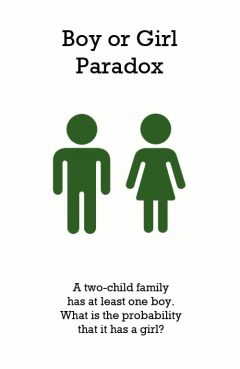Boy Or Girl Paradox

Release Date: //1959
Country of Release:
Length:
MPAA:
Medium: Paradox
Genre:
Release Message: A two-child family has at least one boy. What is the probability that it has a girl? Authored by Martin Gardner.
Description: The Boy or Girl paradox surrounds a well-known set of questions in probability theory which are also known as The Two Child Problem,[1] Mr. Smith's Children[2] and the Mrs. Smith Problem. The initial formulation of the question dates back to at least 1959, when Martin Gardner published one of the earliest variants of the paradox in Scientific American. Titled The Two Children Problem, he phrased the paradox as follows: Mr. Jones has two children. The older child is a girl. What is the probability that both children are girls? Mr. Smith has two children. At least one of them is a boy. What is the probability that both children are boys? Gardner initially gave the answers 1/2 and 1/3, respectively; but later acknowledged that the second question was ambiguous.[1] Its answer could be 1/2, depending on how you found out that one child was a boy. The ambiguity, depending on the exact wording and possible assumptions, was confirmed by Bar-Hillel and Falk,[3] and Nickerson.[4] Other variants of this question, with varying degrees of ambiguity, have been recently popularized by Ask Marilyn in Parade Magazine,[5] John Tierney of The New York Times,[6] and Leonard Mlodinow in Drunkard's Walk.[7] One scientific study[2] showed that when identical information was conveyed, but with different partially ambiguous wordings that emphasized different points, that the percentage of MBA students who answered 1/2 changed from 85% to 39%. The paradox has frequently stimulated a great deal of controversy.[4] Many people argued strongly for both sides with a great deal of confidence, sometimes showing disdain for those who took the opposing view. The paradox stems from whether the problem setup is similar for the two questions.[2][7] The intuitive answer is 1/2.[2] This answer is intuitive if the question leads the reader to believe that there are two equally likely possibilities for the sex of the second child (i.e., boy and girl),[2][8] and that the probability of these outcomes is absolute, not conditional.[9]